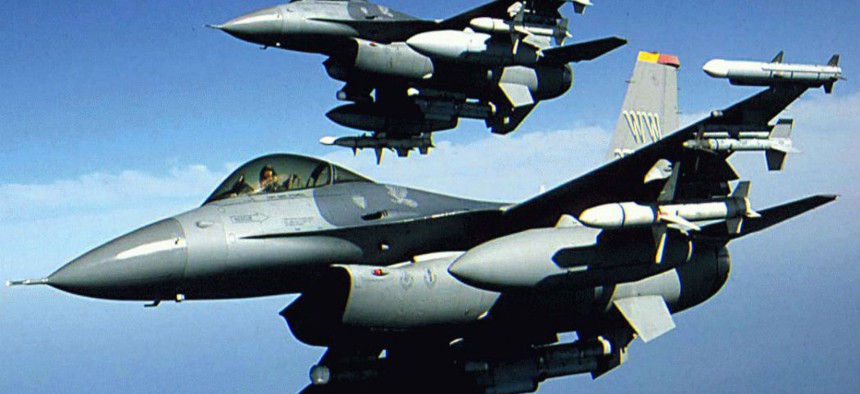Air Force expands QF-16 training to manned and unmanned missions
Air Force plans to add 18 training aircraft by 2021
The U.S. Air Force is expanding its ability to train new pilots by converting out-of-commission F-16s into QF-16 Full Scale Aerial Target (FSAT) aircraft for manned and unmanned missions. The QF-16 FSAT is the leading aircraft for teaching new weapons, tactics, and technologies, including unmanned technologies, to U.S. Air Force pilots.
“The current threat environment is expanding, with existing adversaries and emerging near-peer competitors located and operating around the world. Thus, the QF-16 program is critical for maintaining readiness, as well as assisting DOD in leveraging critical partnerships with allies and partners to sustain presence, support deterrence, and provide combat capability in every region of the world,” said Air Force spokeswoman Emily Grabowski.
Boeing’s QF-16 Full Scale Aerial Target program was the first program to successfully complete software tests in a systems integration lab (SIL) environment, with the assistance of their partner BAE Systems. When applied to a converted retired F-16, this FSAT technology allows Air Force trainees to practice with new technologies and combat tactics in the most representative simulation of actual combat.
“QF-16 provides realistic live fire test and evaluation capability for weapons systems to comply with United States Code, Title X, Section 2366 Live Fire/Lethality requirements prior to entering into full rate production,” said Air Force officials from the Air Force Lifecycle Management Center Armament Directorate at Eglin Air Force Base, FL.
Another notable feature of the QF-16 is its drone capabilities, or “unmanned mode,” where the aircraft is controlled by a ground-based drone control system. Drone capabilities of this aircraft include auto takeoff, a series of simulated maneuvers, supersonic flight, and auto land.
In May of 2012, the U.S. Air Force and Boeing completed the first manned flight of the QF-16 in Jacksonville, FL.. On September of 2013, the first unmanned flight of the QF-16 was successfully completed at Tyndall Air Force Base, FL.
In addition, the QF-16 can simulate live fire tests, and has Peculiar Support Equipment with the highest capability test and fault isolation. The QF-16 also has a modular payload design to make programming the aircraft simpler.
“The QF-16 Full Scale Aerial Target replaces the QF-4 Full Scale Aerial Target as the next generation of combat training and testing for our nation’s warfighters,” Air Force officials stated.
It is designed to provide 4th generation fighter capabilities to the FSAT program, meaning its utilization creates a realistic, challenging threat environment for the warfighter.
The Air Force has finalized a deal with Boeing for a $24 million modification to a previously awarded contract. This modification is for 18 newly renovated QF-16 FSAT aircraft as well as 18 four-year warranties which cover the QF-16’s drone-peculiar equipment program.
The initial QF-16 production contract was finalized in March 2010 for $70 million. As a result, Boeing converted retired F-16s into QF-16 FSATs—both manned and unmanned—to serve as aircraft for combat training and testing. Boeing produced QF-16s with the full-scale aerial targeting capabilities exclusively for the U.S. Air Force.
Grabowski said the initial QF-16 contract “allowed for the initial engineering, manufacturing and development as well as production of up to 127 QF-16 Full Scale Aerial Targets.”
“Boeing is finishing production on Lot 2 currently, and we received the first Lot 3 aircraft last week from the U.S. Air Force. QF-16 production is steady at a rate of two aircraft per month. We have delivered 27 aircraft to the U.S. Air Force, to date,” said Boeing representative Deborah VanNierop.
Currently, QF-16 aircraft are being used for testing at Holloman Air Force Base, NM and at Tyndall Air Force Base, FL. The work is slated to be finished by 2021.
NEXT STORY: DARPA funds new electronics revolution




